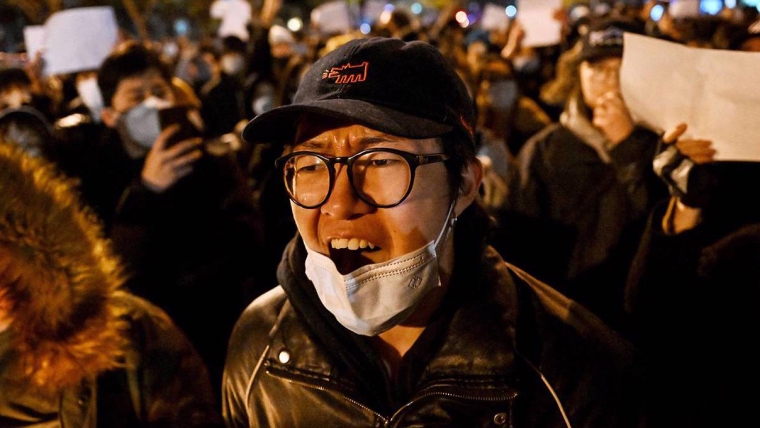
Following a deadly fire in a residential building in China’s Xinjiang region – which many blame on COVID-19 lockdowns – Chinese protesters have taken to the streets to demand an end to stringent pandemic restrictions. Even before the protests erupted, there were signs that President Xi Jinping’s administration was preparing to roll back the costly zero-COVID policy, though the exact timeline remains uncertain. But this process will be more complicated than many seem to realise.
China’s exit from zero-COVID clearly carries public-health risks that must be managed, especially given low vaccination rates among the elderly. Less noticed, however, are the operational challenges this process raises.
As China has learned from Hong Kong’s painful experience, a wave of infections in a densely populated area can create a sudden surge in demand for medical resources, paralyzing the public-health system. If the government fails to find a way to meet that demand quickly, the death toll – especially among the elderly – could soar.
The need to prevent such a demand shock explains why countries have largely taken a gradual approach to lifting pandemic-control measures. But for a country with strong centralised control, China has the advantage of staging its gradual re-opening not only in a temporal sense, but geographically as well.
China’s economic reform and opening up over the past four decades offers useful lessons. Rather than opening the entire economy to the outside world in one fell swoop, China began by designating four mainland cities as special economic zones. Soon after, it opened up 14 other coastal cities. It then gradually replicated the now-proven model in the rest of the country.
From an operational standpoint, this gradual approach offered several obvious advantages. The central government was able to contain – and thus manage – the risks associated with market reform. Moreover, it was able to experiment, accumulate experience, and collect data, which built up people’s confidence and guided the expansion of reforms. And it was able to mobilise talent from across the country to support relevant initiatives.
In exiting from zero-COVID, China can take a similar approach, carving out “special health zones” in high-risk and well-resourced cities, such as Guangzhou, which recently experienced a surge in cases. Such zones will enjoy looser pandemic restrictions, but face limits on movement to other cities and regions.
China’s government can gather data about the impact of easing pandemic restrictions within these contained zones before loosening restrictions more broadly. If a health-care crisis were to emerge in one of these zones, it would be contained, making the surge in demand for critical medical supplies and personnel much easier to meet, not least by ensuring that resources from areas still adhering to the zero-COVID policy could be reallocated.
China has experience with such resource pooling: during Shanghai’s lockdown earlier this year, more than 38,000 medical personnel from 15 Chinese provinces traveled to the city to help tackle the case surge. But, amid an exit from zero-COVID, resource pooling would need to be organised on a much larger scale, with more careful advance planning.
Intuitively, resources should be pooled at a subnational level, with unmet demand in one region met by excess supply from neighboring regions. In this way, resources would need to be carried over relatively shorter distances, making transport faster and cheaper.
But this approach also has a notable limitation: given that neighboring regions tend to have strong economic ties, it makes sense for those near the special health zones to be next in line to have their pandemic restrictions loosened. Once that happens, a rise in COVID-19 cases – and demand for medical resources in the neighboring regions – can be expected. If their medical resources have already been sent to the special zones, they will quickly confront a shortage of medical supplies and personnel.
Given this, regional resource pooling should be complemented by a national-level system. That way, resources can be transferred across distant regions, which are more likely to be at different stages of re-opening.
This larger-scale effort would require advance preparation and coordination between the central government and subnational governments at all levels. Local governments must identify “disposable” medical resources that, if contributed to the resource “pool,” would not cause a significant decline in the quality of local services. The central government, for its part, must devise standard operating procedures to ensure that the different regions’ resource pools cooperate seamlessly.
In the meantime, the central government could create one or multiple centralised distribution hubs to hold medical resources for shipment to regional centers. It could also assemble a team of specialised medical workers to be dispatched to special health zones on demand. Fortunately, China’s highly centralised political system is well-suited for such large-scale and complex endeavors.
Despite the surge in popular unrest, China’s exit from zero-COVID will not happen overnight. Instead, it is likely to be carried out in a gradual and controlled manner, much like China’s economic reform and opening up. That said, China’s leaders must move much faster than they did four decades ago. With a carefully devised operational strategy, there is a good chance that they can pull it off.
S. Alex Yang is Associate Professor of Management Science and Operations at London Business School. Angela Huyue Zhang is Professor of Law at the University of Hong Kong and the author of Chinese Antitrust Exceptionalism: How the Rise of China Challenges Global Regulation (Oxford University Press, 2021). Copyright: Project Syndicate, 2022, published here with permission.
4 Comments
The approach suggested here requires pristine surveilance, monitoring, and control over the general population; something which China has in spades, and New Zealand wants.
Our lockdowns were eventually backpedalled due to public opposition, which is something we should be thankful for. They won't have that same luxury in China.
In hindsight, it probably wasn't a good idea to make the virus was it China.
At least they know what it can do to you. And they are avoiding it like the plague. Makes me wonder what they know and we don’t.
I imagine that if they had a vaccine that actually was safe and effective at stopping transmission of the virus then they could significantly ease up on other virus transmission-prevention measures knowing that the people would be safe.
Meanwhile what are we doing here in NZ these days? Nothing effective. And people are still dying from the virus as a result of there being no _proven_ actually safe and actually effective vaccine.

We welcome your comments below. If you are not already registered, please register to comment
Remember we welcome robust, respectful and insightful debate. We don't welcome abusive or defamatory comments and will de-register those repeatedly making such comments. Our current comment policy is here.